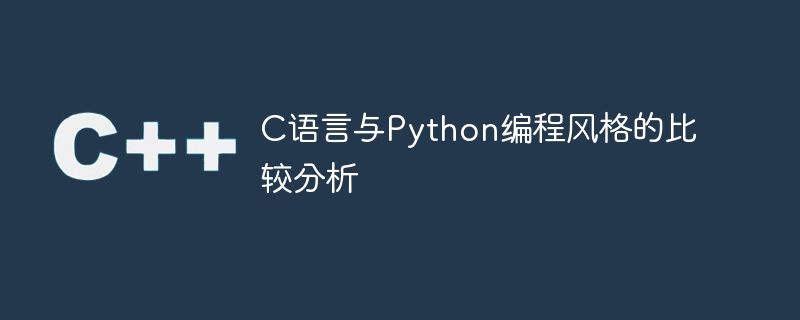Home >Backend Development >C++ >Comparative analysis of C language and Python programming styles
Comparative analysis of C language and Python programming styles
- WBOYWBOYWBOYWBOYWBOYWBOYWBOYWBOYWBOYWBOYWBOYWBOYWBOriginal
- 2024-03-18 15:30:041145browse

Comparative analysis of C language and Python programming styles
In recent years, with the popularity of computer programming, C language and Python have become the two most popular programming styles One of the languages. Although they both have powerful programming capabilities, there are obvious differences in programming styles. This article will conduct a comparative analysis of the styles of the two programming languages, C and Python, and demonstrate the differences between them through specific code examples.
1. Syntax simplicity
First of all, C language is a structured programming language with a relatively low-level syntax that requires programmers to manually manage memory. Python is a high-level programming language with concise and clear syntax that supports multiple programming paradigms such as object-oriented and functional programming. The following is a simple example, showing the code to output "Hello, World!" in C language and Python respectively:
C language example:
#include <stdio.h>
int main() {
printf("Hello, World!
");
return 0;
}Python example:
print("Hello, World!")As can be seen from the above example, Python code is relatively more concise and easy to read, while C The language's code appears to be more verbose.
2. Type constraints
In C language, variables need to explicitly declare their type, while Python is a dynamically typed language and does not need to specify the type of variables in advance. The following is a simple example showing how variables are declared in C language and Python:
C language example:
int a = 10; char b = 'A'; float c = 3.14;
Python example:
a = 10 b = 'A' c = 3.14
As you can see, there is no type declaration in Python code. Programmers can change the type of variables at will, while C language needs to clearly define the type of variables.
3. Function definition
In C language, the definition of a function is usually strict and needs to include the function name, parameter list and return type. In Python, function definition is relatively more flexible and does not require specifying parameters and return types. Here is a simple example showing how functions are defined in C and Python:
C language example:
int add(int a, int b) {
return a b;
}Python example:
def add(a, b):
return a bAs you can see, the function definition in Python is more concise and flexible, and there is no need to declare the return type.
To sum up, there are obvious differences in programming styles between C language and Python. C language pays more attention to low-level details and performance, requiring programmers to manage memory; while Python pays more attention to simplicity and readability, and is suitable for rapid development and prototyping. When choosing a programming language, you need to select the appropriate language based on specific needs and projects to better realize the functionality and efficiency of the program.
The above is the detailed content of Comparative analysis of C language and Python programming styles. For more information, please follow other related articles on the PHP Chinese website!

